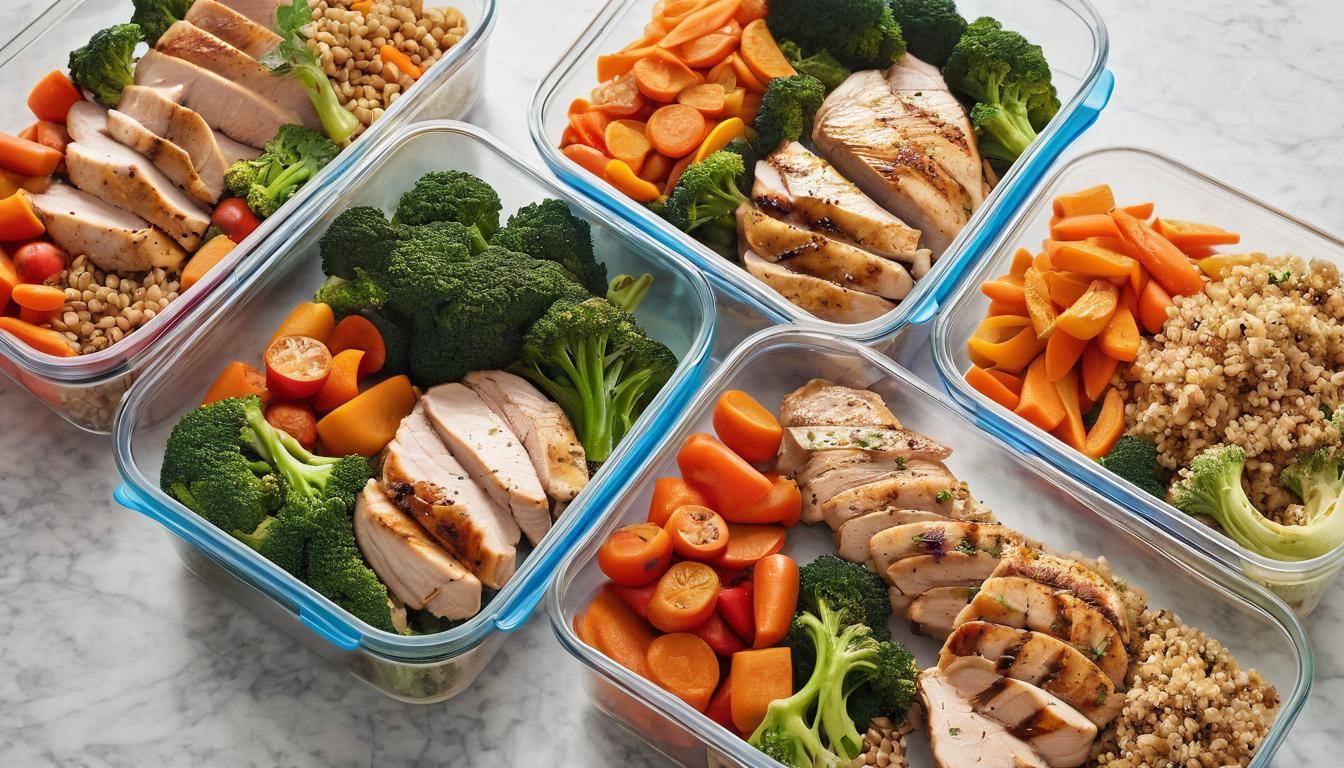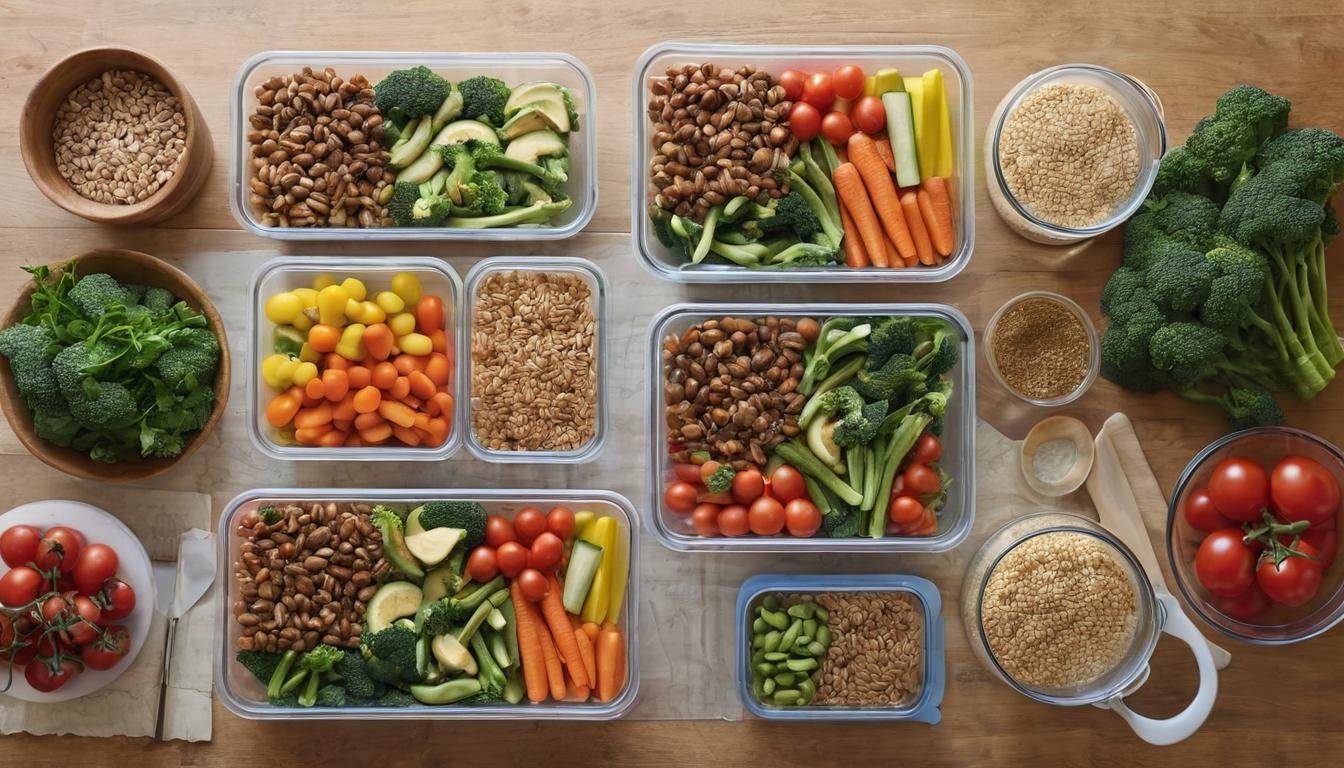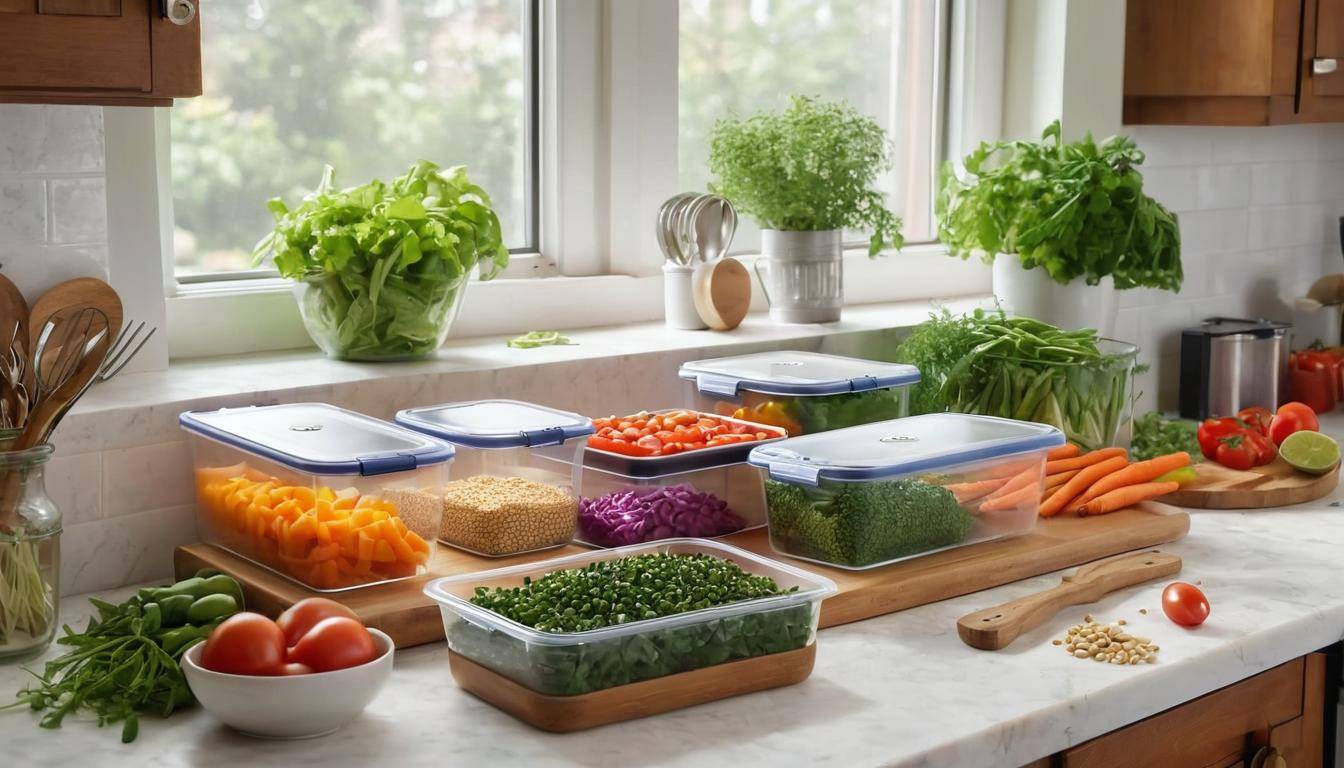You’re busy balancing work, yoga classes, and weekend hikes. Finding time to prepare healthy meals shouldn’t add to your stress. Yet, it’s all too easy to fall back on fast food when you’re rushed. This is where simple meal prepping steps in—offering a way to stick to a nutritious diet without breaking the bank or sapping your precious time.
Carefully planning meals might sound overwhelming at first, but imagine starting your week knowing exactly what you’ll eat each day. From fresh overnight oats ready in the fridge to protein-packed lunches easily reheated at work, these strategies can become part of a seamless routine. We’ve invested significant time gathering practical advice and creative recipes for you, ensuring this process actually simplifies rather than complicates your life. Now let’s explore how you can transform your hectic schedule with effective meal prepping techniques.
Simple meal prepping for a healthy week involves selecting nutritious recipes that can be batch-cooked, such as quinoa salads or vegetable stir-fries, and organizing your cooking session on the weekend. Additionally, using airtight containers for storage and preparing individual portions can help you stay on track with your dietary goals while saving time during busy weekdays.

Important Tips for Easy Meal Prepping
Understanding how to efficiently manage meal prep is crucial for maintaining a nutritious diet. Planning ahead is not just a suggestion—it’s an essential first step. By strategically laying out your meals for the week, you save valuable time and reduce the likelihood of resorting to unhealthy choices.
A well-organized weekly planner can be your best friend here; sketch out what you’ll have for breakfast, lunch, and dinner each day. Imagine dedicating Monday to vibrant Mediterranean flavors like quinoa salads while saving Tuesday for lean proteins, such as succulent chicken breast paired with colorful mixed vegetables. This creates a roadmap that makes shopping and cooking easier.
Planning your meals can help you remain committed to the healthy lifestyle you aspire to achieve.
Next comes the art of shopping smart. Crafting a comprehensive shopping list based on your carefully planned meals is not just practical—it’s transformative. As you navigate your local grocery store, grouping items by sections (like produce, dairy, grains) reduces wandering and helps keep you focused on your objectives. A valuable tip here is to buy in bulk. This not only cuts costs but also allows you to stock up on staples like grains and legumes that can be used throughout the week.
Additionally, opting for seasonal produce ensures you’re getting fresh and nutrient-dense ingredients that not only taste better but are often less expensive.
After you’ve mastered planning and shopping, it’s time to implement batch cooking. Set aside a block of time during your weekend—this could be two to three hours—to prepare large quantities of food. This means throwing a tray of assorted vegetables into the oven, simmering a big pot of brown rice, or grilling several chicken breasts all at once. Since many dishes hold up beautifully in the refrigerator or freezer, this approach drastically minimizes stress on busy weekdays when time is limited.
Each dish you prepare serves as a building block for quick meals later in the week, allowing you to mix and match as creativity strikes.
Now that we’ve established these foundational tips for meal prepping effortlessly, let’s explore some delicious recipes that will make your healthy eating journey enjoyable and satisfying.
Simple and Tasty Breakfasts
When it comes to meal prepping for breakfasts, efficiency and flavor should go hand in hand. A well-prepared breakfast not only fuels your body but also jumpstarts your metabolism. It serves as a foundation for your day, making it essential to choose meals that are both nutritious and enjoyable. One of the most adaptable dishes for this purpose is overnight oats, which can be customized to keep your taste buds excited throughout the week.
Overnight Oats Mastery
To master overnight oats, start with a base of rolled oats and chia seeds combined with almond milk. The beauty of overnight oats lies in their flexibility—think of them as a blank canvas you can embellish each evening. If you prefer a bit of sweetness, add a drizzle of honey or maple syrup before sealing the jar and letting it rest in the refrigerator.
As morning arrives, all you need to do is grab your jar, give it a gentle shake, and layer on fresh fruit like berries, bananas, or even a handful of nuts for added crunch. Adding ingredients such as peanut butter not only enhances the flavor but also provides an extra protein boost that will help keep you satisfied until lunch. Feel free to experiment; perhaps topping with shredded coconut or sprinkling cinnamon will brighten up your morning routine.
Now, let’s elevate your breakfast game even further by exploring another fulfilling option.
Egg Muffins for Protein Boost
Alongside overnight oats, consider incorporating egg muffins into your meal prep repertoire. Begin by whisking together eggs with your choice of vegetables—spinach and bell peppers pair exceptionally well for a colorful dish—and just a sprinkle of cheese for creaminess. Once combined, pour the mixture into a muffin tin, filling each cup about three-quarters full.
Bake these delightful muffins until they’re puffed and set; allow them to cool before transferring them to an airtight container. Their convenience is unparalleled: when you’re pressed for time, simply reheat one (or two) in the microwave for a protein-packed start to your day.
Testimonials from fans highlight how these egg muffins have become a lifesaver during busy mornings. “I can grab one on my way out the door,” shared one reader, “and they keep me full until lunch.” It’s this blend of practicality and satisfaction that makes meal prepping not just beneficial but also enjoyable.
With breakfast taken care of, preparing healthy lunches can seamlessly follow while ensuring you maintain variety in your meal plan throughout the week.
Nutritious Lunches for Your Work Week
One of the greatest benefits of preparing your lunches in advance is that it helps you steer clear of unhealthy options that can derail your diet. Instead of scrolling through takeout menus or indulging in fast food, having satisfying, healthy meals ready to go makes lunchtime a breeze. Consider balancing proteins, whole grains, and plenty of fresh vegetables; this combination offers sustained energy and keeps you satisfied until dinner.
Quick Mediterranean Quinoa Salad
One delightful option is the Quick Mediterranean Quinoa Salad. This recipe is not only colorful but also packed with flavor and nutrients. Imagine sitting down to a bowl filled with cooked quinoa, vibrant cherry tomatoes, crisp cucumber, zesty red onion, briny olives, and creamy feta cheese. To prepare this dish, combine all the ingredients in a large bowl, drizzling them with olive oil and fresh lemon juice to brighten the flavors. By tossing everything together gently, you ensure that every bite bursts with freshness. Notably, this salad stores well in individual containers, allowing you to grab a serving whenever hunger strikes.
Next on the list of satisfying lunches is something warm and comforting.
Hearty Lentil Soup
Another excellent meal prep idea is the Hearty Lentil Soup. Picture yourself coming home after a long day to a steaming bowl of homemade soup—it’s as simple as sautéing onions, carrots, and celery to create a savory base. Once those veggies are soft and aromatic, adding lentils, diced tomatoes, vegetable broth, and spices like cumin and turmeric will transform your kitchen into a fragrant haven. Letting it simmer until the lentils soften yields not just nourishment but also comfort in every spoonful. A quick tip is to freeze individual servings for those busy days when you don’t have time to cook—just thaw and heat!
As we explore another delicious option that encourages customization…
DIY Burrito Bowls
Lastly, consider crafting your own DIY Burrito Bowls. They offer adaptability and creativity for anyone looking to personalize their meals! Start by choosing a base—either brown rice or quinoa—and layer on nutrient-packed black beans for protein. Then comes grilled chicken or tofu for an extra protein boost, followed by sautéed bell peppers and onions for texture and flavor. To finish things off, don’t forget salsa and guacamole; they add zest while providing healthy fats! The beauty of burrito bowls is that they can be tailored to your taste preferences or dietary needs—you can even switch out ingredients according to what you have on hand.
Preparing these nutritious lunches ultimately saves money and reduces waste while ensuring you enjoy nourishing meals throughout your workweek. With these hearty options at your fingertips, it’s time to venture into flavorful dishes ideal for evenings filled with warmth and satisfaction.
Healthy Dinner Ideas
Preparing healthy dinners ahead of time can be a game-changer for your week. Not only does it save time after long days at work, but it also ensures that you have wholesome options ready to go. Imagine walking into your kitchen after a tiring day, knowing that a delicious homemade meal awaits you—warm, comforting, and nutritious. This peace of mind can dramatically reduce stress while fostering better eating habits.
Baked Salmon with Veggies
One of my favorite recipes is baked salmon with veggies. Salmon is packed with omega-3 fatty acids, which are great for heart health. Here’s how I approach this dish:
First, preheat your oven to 375°F. While it heats up, place salmon fillets on a baking sheet and season them simply with lemon, dill, salt, and pepper. Surround the salmon with vibrant vegetables like bell peppers, zucchini, and cherry tomatoes, all tossed in olive oil to enhance flavor. After about 20 minutes in the oven, you’ll have a colorful, nutrient-dense dinner that’s ready to be enjoyed.
Moving from fish to poultry, let’s explore another crowd-pleaser that epitomizes convenience.
One-Pot Chicken and Brown Rice
One-pot meals simplify cooking, reducing both prep and cleanup time. My go-to is a hearty chicken and brown rice dish.
Start by browning seasoned chicken thighs in a large pot until perfectly golden. Once they’re sizzling, add in chopped onions, garlic, carrots, and celery—cooking until softened creates an aromatic base that makes the mouth water just thinking about it! Next comes the brown rice and chicken broth; this mix brings everything together beautifully. Bring it to a boil before lowering the heat to let it simmer gently until the rice is tender and the liquid has been absorbed. What’s left is a satisfying meal that packs flavor while offering balanced nutrition.
If you’re looking for something even quicker yet equally delightful, stir-fries shine as a versatile dinner option.
Veggie-Packed Stir-Fry
Stir-fries are perfect when you’re pressed for time but still want a colorful plate full of nutrients. They allow for creativity along with varying tastes based on what you have available.
Begin by sautéing an assortment of your favorite vegetables—think broccoli, snap peas, and vibrant bell peppers—in a hot pan with some olive oil or sesame oil for an extra punch of flavor. To make it more filling, consider adding tofu or shrimp; both options complement the veggies beautifully! Finally, serve your stir-fry over brown rice or quinoa to round off the meal with healthy carbohydrates that keep energy levels stable throughout the evening.
These dinner ideas not only help develop good eating habits but also align well with achieving overall nutritional goals when prepared thoughtfully and consistently.
Balancing Nutritional Needs

A well-rounded diet acts as a foundation for vitality and resilience, ensuring your body has the energy it needs while also keeping you healthy. One of the most effective methods for achieving this balance is through careful consideration of macronutrients in each meal. These macronutrients—proteins, fats, and carbohydrates—play distinct yet interconnected roles in your body. It’s essential to understand how much of each is appropriate for your lifestyle and goals.
Understanding Macronutrients
Let’s break these down further. Proteins are often hailed as the body’s building blocks. They are crucial for muscle repair and growth after physical activities, making them vital if you’re aiming for fitness or recovery. For a protein boost, focus on lean meats like chicken, fish, legumes such as lentils or chickpeas, and dairy products like Greek yogurt, which are also excellent sources of calcium.
But it doesn’t end there; healthy fats are equally important.
Healthy fats contribute significantly to brain health by providing essential fatty acids that aid cognitive functions. Foods like avocados, nuts, seeds, and olive oil not only nourish your mind but help keep hunger at bay longer. Additionally, carbohydrates shouldn’t be overlooked; they are the primary source of energy for our daily activities. Opt for carbohydrates from whole grains like brown rice or quinoa and plenty of colorful vegetables that enrich both flavor and nutrition.
Plate Portioning
Striking the right balance involves implementing visual guidance as well. The general dietary guideline suggests that half your plate should consist of a variety of vegetables and fruits—rich in vitamins and antioxidants—while one-quarter should be dedicated to protein sources high in nutrients, with the remaining quarter reserved for grains. This simple division can provide a clear framework during meal prep.
A useful strategy to control portion sizes effectively is to use smaller plates. This can trick our minds into feeling satisfied with less food while still enjoying all the variety present on our plates.
Keeping these elements in mind when preparing meals can empower you to eat more consciously. As we explore practical ways to make meal preparation cost-effective, you’ll find guidance that aligns with your health goals while also being budget-friendly.
Budgeting with Meal Prep

One of the remarkable aspects of meal prepping is its potential to significantly cut down on your grocery bills. When you adopt a structured approach to your meals, you can maximize savings without sacrificing nutrition. By planning meals in advance, you avoid last-minute takeout and impulse purchases at the grocery store that can quickly add up.
Meal Prepping on a Budget
One of the best tips for sticking to a budget while meal prepping is to buy in bulk whenever possible. Grains, lentils, and beans are inexpensive staples that can be purchased in larger quantities, allowing you to prepare multiple meals throughout the week. For example, brown rice, black beans, and chicken breast can serve as the foundations for several dishes.
| Ingredient | Cost (per lb) | Servings (per lb) |
|---|---|---|
| Brown Rice | $1 | 10 |
| Black Beans | $1.50 | 8 |
| Chicken Breast | $3 | 4 |
As illustrated in the table above, these ingredients offer not just affordability but also versatility. You can whip up numerous meals using these components—think burrito bowls, grain salads, and hearty stews.
Cost-Effective Recipes
Beyond just buying ingredients smartly, consider recipes that allow for batch cooking. A large pot of chili is both budget-friendly and nutritious. It combines ground turkey or beef with beans and tomatoes simmered together until the flavors meld into a satisfying dish. Not only does it provide multiple hearty servings, but it also freezes well—ensuring you’re set for weeks ahead without breaking the bank.
With these cost-effective strategies in place, you’ll not only enjoy delicious meals all week long but also feel empowered about your financial choices when it comes to food.
By embracing meal prepping while being mindful of your budget, you can enjoy nutritious meals throughout the week without financial strain. This approach encourages healthy eating habits and maximizes your resources effectively.
